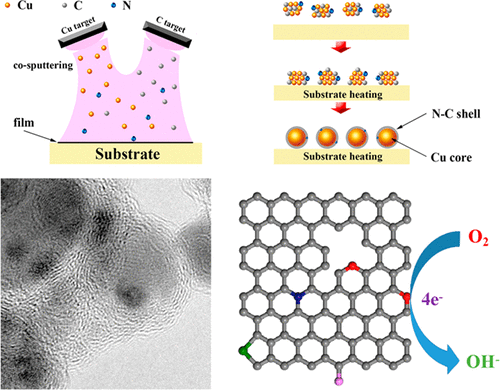当前位置:
X-MOL 学术
›
ACS Appl. Mater. Interfaces
›
论文详情
Our official English website, www.x-mol.net, welcomes your
feedback! (Note: you will need to create a separate account there.)
Magnetron Sputtering Deposition [email protected] N–C as High-Performance Electrocatalysts for Oxygen Reduction Reaction
ACS Applied Materials & Interfaces ( IF 8.3 ) Pub Date : 2017-11-17 00:00:00 , DOI: 10.1021/acsami.7b16682 Hongyang Shao 1 , Xiaoming Zhang 2 , Hao Huang 3 , Kan Zhang 1 , Menglong Wang 1 , Cai Zhang 1 , Yifan Yang 1 , Mao Wen 1 , Weitao Zheng 1
ACS Applied Materials & Interfaces ( IF 8.3 ) Pub Date : 2017-11-17 00:00:00 , DOI: 10.1021/acsami.7b16682 Hongyang Shao 1 , Xiaoming Zhang 2 , Hao Huang 3 , Kan Zhang 1 , Menglong Wang 1 , Cai Zhang 1 , Yifan Yang 1 , Mao Wen 1 , Weitao Zheng 1
Affiliation

|
The idea of a core–shell structure can promote the utilization of nonprecious metallic catalysts by enhancing their activity and stability for the oxygen reduction reaction (ORR). Developing a low-cost, high-efficiency, and high-reproducibility method for synthesizing core–shell-structured materials represents an urgent challenge. Here, we fabricate encapsulated Cu nanoparticles with nitrogen-doped onion-like graphite nanoshells ([email protected] N–C) as an efficient ORR catalyst by magnetron sputtering, in which the graphite shells grow by an in situ self-assembly process activated by the surface-catalyzed behavior with Cu nanoparticles. The results show that the CuCN-650 °C catalyst achieves the optimized [email protected] N–C structure with small-sized Cu nanoparticles and a few-layer nanoshells and exhibits excellent ORR electrocatalytic properties, including a half-wave potential and onset potential similar to those of commercial Pt/C, coupled with better stability and higher methanol tolerance than for commercial Pt/C in alkaline electrolytes. The internal Cu nanoparticles in the core–shell structure not only promote the formation of a high content of pyridinic N but also donate the electronic charges to outer N-doped C shells, and thus the synergistic effect between the encapsulated Cu nanoparticles and N-doped C shells is responsible for the excellent electrocatalytic activity for the ORR.
中文翻译:

磁控溅射沉积[电子邮件保护] N–C作为高性能的氧还原反应电催化剂
核-壳结构的想法可以通过提高非贵金属催化剂对氧还原反应(ORR)的活性和稳定性来促进其利用率。开发低成本,高效率和高重现性的方法来合成核-壳结构材料是一项迫在眉睫的挑战。在这里,我们通过磁控溅射制备具有氮掺杂洋葱状石墨纳米壳([电子邮件保护] N–C)作为有效的ORR催化剂的包封Cu纳米颗粒,其中石墨壳通过原位自组装过程被激活Cu纳米粒子的表面催化行为。结果表明,CuCN-650°C催化剂以小尺寸的Cu纳米颗粒和几层纳米壳实现了优化的[电子邮件保护] N–C结构,并显示出优异的ORR电催化性能,包括半波电势和启动电势与商用Pt / C相似,在碱性电解液中比商用Pt / C具有更好的稳定性和更高的甲醇耐受性。核-壳结构中的内部Cu纳米颗粒不仅促进了高含量的吡啶N的形成,而且还向外部的N掺杂的C壳提供了电荷,因此,包封的Cu纳米颗粒与N掺杂之间具有协同作用C壳负责ORR的出色电催化活性。包括与商用Pt / C相似的半波电势和起始电势,以及在碱性电解液中比商用Pt / C更好的稳定性和更高的甲醇耐受性。核-壳结构中的内部Cu纳米颗粒不仅促进了高含量的吡啶N的形成,而且还向外部的N掺杂的C壳提供了电荷,因此,包封的Cu纳米颗粒与N掺杂之间具有协同作用C壳负责ORR的出色电催化活性。包括与商用Pt / C相似的半波电势和起始电势,以及在碱性电解液中比商用Pt / C更好的稳定性和更高的甲醇耐受性。核-壳结构中的内部Cu纳米颗粒不仅促进了高含量的吡啶N的形成,而且还向外部的N掺杂的C壳提供了电荷,因此,包封的Cu纳米颗粒与N掺杂之间具有协同作用C壳负责ORR的出色电催化活性。
更新日期:2017-11-17
中文翻译:

磁控溅射沉积[电子邮件保护] N–C作为高性能的氧还原反应电催化剂
核-壳结构的想法可以通过提高非贵金属催化剂对氧还原反应(ORR)的活性和稳定性来促进其利用率。开发低成本,高效率和高重现性的方法来合成核-壳结构材料是一项迫在眉睫的挑战。在这里,我们通过磁控溅射制备具有氮掺杂洋葱状石墨纳米壳([电子邮件保护] N–C)作为有效的ORR催化剂的包封Cu纳米颗粒,其中石墨壳通过原位自组装过程被激活Cu纳米粒子的表面催化行为。结果表明,CuCN-650°C催化剂以小尺寸的Cu纳米颗粒和几层纳米壳实现了优化的[电子邮件保护] N–C结构,并显示出优异的ORR电催化性能,包括半波电势和启动电势与商用Pt / C相似,在碱性电解液中比商用Pt / C具有更好的稳定性和更高的甲醇耐受性。核-壳结构中的内部Cu纳米颗粒不仅促进了高含量的吡啶N的形成,而且还向外部的N掺杂的C壳提供了电荷,因此,包封的Cu纳米颗粒与N掺杂之间具有协同作用C壳负责ORR的出色电催化活性。包括与商用Pt / C相似的半波电势和起始电势,以及在碱性电解液中比商用Pt / C更好的稳定性和更高的甲醇耐受性。核-壳结构中的内部Cu纳米颗粒不仅促进了高含量的吡啶N的形成,而且还向外部的N掺杂的C壳提供了电荷,因此,包封的Cu纳米颗粒与N掺杂之间具有协同作用C壳负责ORR的出色电催化活性。包括与商用Pt / C相似的半波电势和起始电势,以及在碱性电解液中比商用Pt / C更好的稳定性和更高的甲醇耐受性。核-壳结构中的内部Cu纳米颗粒不仅促进了高含量的吡啶N的形成,而且还向外部的N掺杂的C壳提供了电荷,因此,包封的Cu纳米颗粒与N掺杂之间具有协同作用C壳负责ORR的出色电催化活性。











































 京公网安备 11010802027423号
京公网安备 11010802027423号